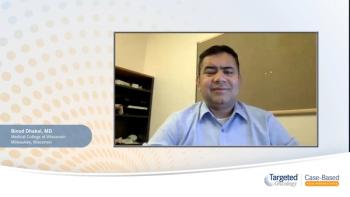Case-Based Peer Perspectives: A 72-Year-Old Man With Relapsed/Refractory Multiple Myeloma (RRMM)

Panelist discusses the clinical patient, a 72-year-old man who was previously diagnosed 6 years ago with multiple myeloma, 60% plasma cells, which he presents to his oncologist after 5 prior treatment regimens. The patient also has had 2 episodes of pneumonia and multiple episodes of bronchitis over the prior 10 years.

Panelist discusses how the RRMM treatment landscape has evolved significantly, with BiTEs emerging as a promising approach. BCMA-targeted BiTEs showed efficacy, while GPRC5D-targeting agents like talquetamab represent promising new options, particularly for patients with BCMA-refractory disease. Key challenges include managing cytokine release syndrome, developing optimal sequencing strategies, addressing drug resistance, and improving accessibility and affordability of novel therapies.

Panelist discusses how the MonumenTAL-1 study led to the approval of talquetamab in patients with 4 or more prior lines of therapy, and the initial response rate was 70%. There were also several toxicities associated with MonumenTAL-1, including oral, nail, and skin toxicities.

Panelist discusses how talquetamab’s step-up dosing strategy aims to mitigate cytokine release syndrome, a common immunologic toxicity. The reported grade 1 CRS with altered taste and dry mouth represents a mild manifestation compared with the MonumenTAL-1 trial, where the initial SUD schedule showed varying CRS rates. Real-world evidence has largely validated trial findings, though alternative SUD approaches may offer different risk-benefit profiles. The optimal SUD strategy continues to evolve as clinical experience expands, balancing efficacy with tolerability.

Panelist discusses how, based on the patient achieving sCR with emerging oral, skin, and nail toxicities, panelist would recommend initiating supportive care, including oral hygiene protocols, topical treatments, and prophylactic nail care. These toxicities are generally less severe than those of BCMA-targeted bispecifics, which often present with more systemic CRS and neurotoxicity.

Panelist discusses how pivotal studies led to the approval of teclistamab in patients with less refractory multiple myeloma; the overall response rate was 63% and the progression of survival rate was 11.3 months.

Panelist discusses how there are many significant attributes of the bispecific antibody, which has broader applicability and can be used in widespread community centers. There are more community centers that are staring to use bispecific antibodies, and there is now a much lower rate of CRS and immune effector cell–associated neurotoxicity syndrome (ICANS).



